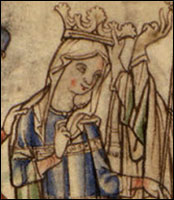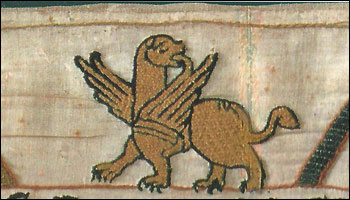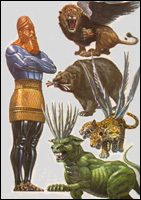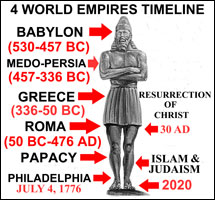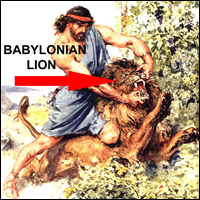THE TREE IN THE MIDDLE OF THE EARTH THAT WAS VISIBLE TO THE ENDS OF THE EARTH SYMBOLIZES THE
BRITISH BABYLONIAN EMPIRE (DANIEL 4:10-12). THE BRITISH LION IS THE FEROCIOUS BABYLONIAN LION THAT IS DEPICTED IN THE BAYEAU TAPESTY AND THE CATHOLIC BIBLE AS A LIONESS (DANIEL 7:2-2). |
The Bayeux papestry is a fabrication because the Battle of Hastings never happened. King Harold of England was killed by Viking King Harald of Norway at the Battle of Stamford Bridge on September 25, 1066.
The distance from Stanford Bridge to Hastings is 270 miles (432 km). If King Harold survived that battle there was no time for him to march his army to Hastings. That is why the conspiracy was very strong in 1066.
Before 2430 BC, all mankind spoke one language and that was Hebrew. Babel means CONFUSION because it was the building of the Tower of Babel by the tyrant Nimrod, and his wicked wife Queen Semiramis, that caused JEHOVAH to confound their speech so that they couldn't understand each other (Genesis 11:7).
In 1520, Saint Martin Luther published his magnum opus entitled On the Babylonian Captivity of the Church. His main theme was that the Papacy was Mystery Babylon which had taken the Church captive. St. Martin saw himself as a last days Nehemiah raised up to rebuild the spiritual Temple after the previous 1,000 years desolation.
That book caused consternation at the Vatican, and Saint Martin was ordered to disavow it . . . or face a fiery death . . . like the 3 Hebrew teenagers in King Nebuchadnezzar's fiery furnace (Daniel 3:11).
Even though he wrote a brilliant rebuttal to Sir Thomas More's The Defence of the Seven Sacraments, the Saint did not know that 450 years previously, Satan had established another Babylon . . . not on the Tiber . . . but on the THAMES!
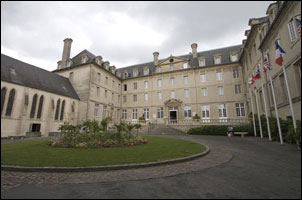 The Musée de la Tapisserie de Bayeux in Bayaux, Normandy. |
|
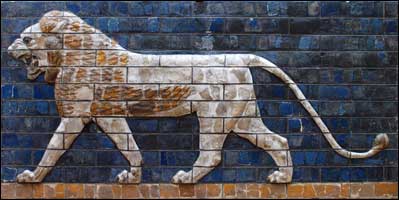 King Nebuchadnezzar of Babylon is depicted as a ferocious lion with the wings of an eagle!! |
It is a miracle that the tapestry has survived at all. Millions of Britons have viewed and admired the tapestry, but failed to comprehend its hidden meaning. Edith of Wessex, "virgin" wife of King Edward, and sister of the slain King Harold, was the creator of the tapestry.
The lioness was the real power behind the throne; she was fluent in 4 languages, and she was thoroughly familiar with the Latin Vulgate Version.
The tapestry depicts a fictitious battle that occurred between King Harold of England and the invader William of Normandy.
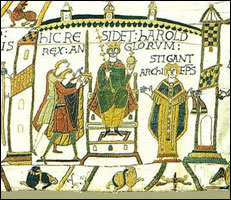 Harold crowned king from the tapestry. |
|
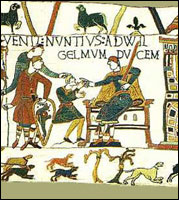 Duke William is shown seated with a huge sword in his hand. |
William certainly lived up to his nickname. The law of primogeniture was unknown in the country at that time. It was adopted as part of the Babylonian Captivity.
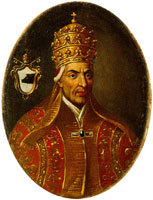 Pope Alexander II (1015–1073). Reigned from 1061 to 1073. |
|
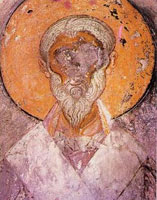 Pope Alexander I of Alexandria (d. 328). |
After the first 1000 years of Christian history had expired, Satan moved westward and concentrated all his diabolical activity on the western isles.

No image exists of Pope George
of Alexandria. |
|
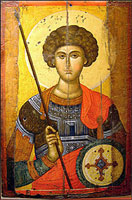 "Saint" George of England is actually Arian Pope George of Alexandria. |
In the Book of Daniel, Nebuchadnezzar is depicted as a winged LION, but the Bayeux Tapestry portrays him as a winged LIONESS. Here is a description of Daniel's dream as recorded in the Douay-Rheims Version:
I saw in my vision by night, and behold the four winds of the heavens strove upon the great sea. And four great beasts, different one from another, came up out of the sea. The first was like a lioness, and had the wings of an eagle: I beheld till her wings were plucked off, and she was lifted up from the earth, and stood upon her feet as a man, and the heart of a man was given to her (Daniel 7: 2-4, Douay-Rheims Version).
That was because the tapestry was the work of the widow of King Edward and the sister of King Harold. Edith was the precursor of Sultana Elizabeth I, and she was ambitious to rule Britannia in her own right.
|
Edith knew how to embroider the Truth, as her 3 brothers were killed by Harald Hardrada at the Battle of Stamford Bridge.
The dream of King Nebuchadnezzar in Daniel Chapter 2 and Daniel's dream in Chapter 7 are parallel or synonymous.
|
After the Babylonian Captivity, powerful women like Eleanor of Aquitaine ruled from behind the scenes, but no female ruled alone until Sultana Elizabeth I in 1559:
So he (angel) carried me away in the spirit into the wilderness: and I saw a woman sit upon a scarlet coloured beast, full of names of blasphemy, having seven heads and ten horns. And the woman was arrayed in purple and scarlet colour, and decked with gold and precious stones and pearls, having a golden cup in her hand full of abominations and filthiness of her fornication: And upon her forehead was a name written, MYSTERY, BABYLON, THE MOTHER OF HARLOTS AND ABOMINATIONS OF THE EARTH (Apocalypse 17:3-5, King James Version).
Around the time of King Alfred there was a female Pope in Roma named Joan, but that was the first time that the prophecy of a woman riding the beast was fulfilled on the Thames.
King Nebuchadnezzar is depicted as a "great tree" in the middle of the earth
The people who inhabited Britannia before the Captivity were called Anglo-Saxons. Alfred the Great is the best known Anglo-Saxon king. He was a devout Christian and a Bible translator, who encouraged the people to use the English language instead of Latin.
King Alfred spent a great amount of time fighting the Viking invaders . . . who later morphed into Normans.
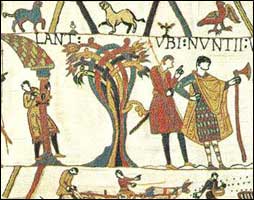 The tapestry depicts Nebuchadnezzar as a great tree. |
|
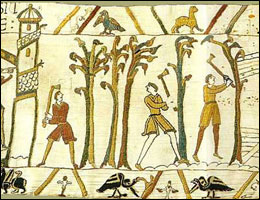 Cutting down the tree symbolized the humbling of Nebuchadnezzar. |
At the height of his pomp and power, Nebuchadnezzar had a dream which only the Prophet Daniel was able to interpret:
Thus were the visions of mine head in my bed; I saw, and behold a tree in the midst of the earth, and the height thereof was great. The tree grew, and was strong, and the height thereof reached unto heaven, and the sight thereof to the end of all the earth: the leaves thereof were fair, and the fruit thereof much, and in it was food for all: the beasts of the field had shade under it, and the birds of the heaven dwelt in the branches thereof, and all flesh was fed from it (Daniel 4:10-12, King James Version).
Nebuchadnezzar dreamed that an angel came down from heaven and cut down the great tree:
I saw in the visions of my head upon my bed, and, behold, a watcher and an holy one came down from heaven; he cried aloud, and said thus, cut down the tree, and cut off his branches, shake off his leaves, and scatter his fruit: let the beasts get away from under it, and the fowls from his branches: nevertheless leave the stump of his roots in the earth, even with a band of iron and brass, in the tender grass of the field; and let it be wet with the dew of heaven, and let his portion be with the beasts in the grass of the earth: let his heart be changed from man’s, and let a beast’s heart be given unto him; and let seven times (7 years) pass over him (Daniel 4:13-16).
Nebuchadnezzar refused to repent of his evil ways so the dream was fulfilled exactly as Daniel predicted:
That very hour the word was fulfilled concerning Nebuchadnezzar; he was driven from men and ate grass like oxen; his body was wet with the dew of heaven till his hair had grown like eagles’ feathers and his nails like birds’ claws. And at the end of the time, I Nebuchadnezzar, lifted my eyes to heaven, and my understanding returned to me; and I blessed the Most High and praised and honored Him who lives forever (Daniel 4: 33-34).
That history concerning the proud and haughty Nebuchadnezzar did have a happy ending, but not the Babylonian Captivity of Britannia.
The tapestry compared King Harold to the blinded King Zedekiah
By the time of the rise of the Babylonian Empire, the Israelites had turned back from following JEHOVAH. They worshipped idols, and even offered their sons and their daughters as sacrifices to Moloch.
The pagan king Nebuchadnazzar was raised up to punish them for their evil ways.
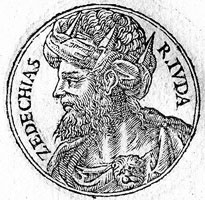 King Zedekiah (b. 539 BC). |
|
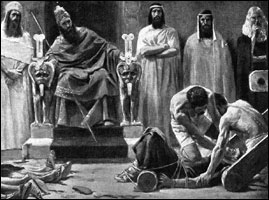 The blinding of King Zedekiah by King Nebuchadnezzar. |
The king and his sons escaped from Jerusalem by night by climbing down a rope:
But the army of the Chaldeans pursued the king, and they overtook Zedekiah in the plains of Jericho. All his army was scattered from him. So they took the king and brought him up to the king of Babylon at Riblah in the land of Hamath, and he pronounced judgment on him. Then the king of Babylon killed the sons of Zedekiah before his eyes. And he killed all the princes of Judah in Riblah. He also put out the eyes of Zedekiah; and the king of Babylon bound him in bronze fetters, took him to Babylon, and put him in prison till the day of his death (Jeremiah 52: 8-11).
The Philistines also blinded Samson after he was ensnared by Delilah. According to the Holy Bible, Zedekiah was a wicked, king who did much evil in the sight of JEHOVAH (II kings 24:19-20, Jeremiah 52:2-3).
Pope Alexander II and Duke William considered King Harold a wicked king because he was not a Roman Catholic and he did not use the Latin Vulgate Version. The tapestry really portrays the Battle of Stamford Bridge where the majority of the Ango-Saxon nobles were slain.
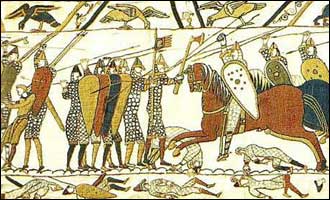 The so-called "Battle of Hastings" as depicted on the tapestry. |
|
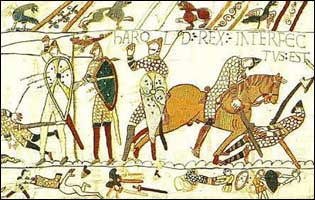 King Harold pulling an arrow out of his eye and then receiving a sword slash on his thigh. |
The tapestry shows the English fleeing before the soldiers of Duke William. That did not happen at the Battle of Stamford Bridge as the Anglo-Saxons fought to the last man.
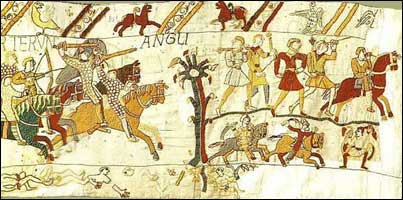 This scene shows the English fleeing before the soldiers of Duke William. |
|
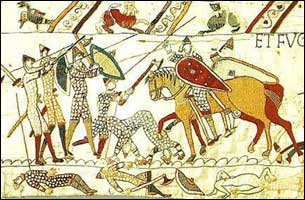 The Normans exulted over their fallen foes. |
That is when he earned the sobriquet "William the Conqueror." The surviving sons of King Harold escaped to Leinster after the Norman Conquest. There they were hosted by the high king of Ireland named Diarmait. The king gave them men and ships to regain the throne, but the Normans were just too powerful, and the great Alfredian dynasty came to a very sad end.
The Normans were absolutely ruthless in governing their conquered kingdom. Anyone opposing them was killed or blinded.
Blinding was synonymous with Norman law enforcement
The Babylonian Captivity of Britannia was a grim episode in that country's history. A virtual reign of terror ensued with thousands killed or blinded. Blinding was the penalty for such a minor offence as poaching. Here is a quote from the Anglo-Saxon Chronicle:
He made great protection for the game
And imposed laws for the same
That those who slew hart or hind
Should be made BLIND.
Thousands were blinded physically for opposing the new Norman regime, but the spiritual blindness imposed by the Babylonian Captivity was far, far worse:
We look for light, but there is darkness! For brightness, but we walk in blackness! We grope for the wall like the blind, and we grope as if we had no eyes; we stumble at noonday as at twilight; we are as dead men in desolate places (Isaiah 59:10).
That was an apt description of England following the dreadful Babylonian Captivity.
The Babylonian Book of Sports was introduced to undermine the Christian Sabbath
Satan hates the Christian Sabbath because it reminds him of the Resurrection of Christ. He always does his utmost to destroy the Christian holy day, and his most zealous helpers are the Muslims, who consign the Sabbath to oblivion when they conquer a country. The cunning and crafty King James I was the first to introduce the Book of Sports in 1618. His successor, Charles I, added severe penalties for non-compliance.
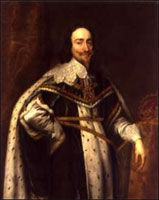 King Charles I (1600–1649). King from 1625 to 1649. |
|
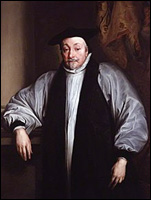 Babylonian Archbishop Laud (1573–1645). |
Any minister not reading the Book of Sports from the pulpit was dismissed with heavy fines. Anybody showing a reluctance to desecrate the Sabbath was immediately reported to Archbishop Laud. The Book of Sports was one of the reasons why the Pilgrim Fathers fled into the New World Wilderness!!
The king and clergy hoped that the merrymaking and frivolity would wean the common people from the Christian Sabbath.
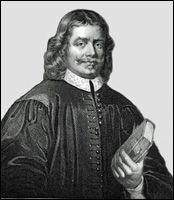 Mechanic for Christ Saint John Bunyan (1628–1688). |
|
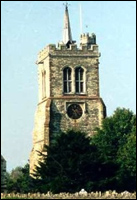 The Babylonian bell tower in Elstow Abbey. |
In 1776, in the British Connecticut colony, general George Washington was fined $5.00 for riding his horse on the Sabbath, and the judge wasn't concerned about the welfare of his horse! Don't visit the birthplace of the fake Shake-speare this year, visit Bedford—the birthplace of Saint John Bunyan—instead!
Nothing has changed in 400 years. Satan still uses sports (Titanic orchestra) to distract the multitudes from the reality of Christ's Resurrection, and a coming Day of Judgment for all mankind.
The British lion symbolizes the Babylonian Empire of Nebuchadnezzar
Lions are not indigenous to Britannia. The lion symbol was adopted after the Babylonian Captivity, and it represents the kingdom of the Chaldeans. It is beyond belief how such an overtly Biblical symbol should be adopted by a nation which honors evolutionist Charles Darwin.
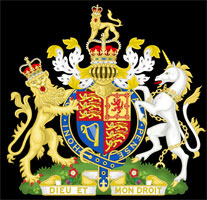 The coat of arms of the U.K. |
|
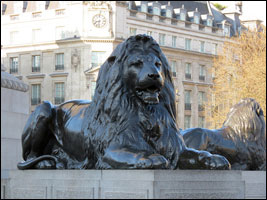 Trafalgar Square Babylonian lion. |
The exciting true story of Samson is an end of the world scenario acted out in history. Mighty man Samson was on his way to Timnath when he was attacked by a lion:
Then Samson went down with his father and his mother, and came to the vineyards of Timnath. And, behold, a young lion roared against him. And the Spirit of JEHOVAH came mightily upon him, and he tore the lion apart as he would have torn apart a young goat, though he had nothing in his hand, but he told not his father or his mother what he had done (Judges 14: 5-6).
The Spirit of JEHOVAH is the Third Person of the Blessed Trinity who proceeds from the Father. Shepherd boy David also killed a lion with his bare hands after Samuel anointed him with oil (symbol of the Holy Spirit).
|
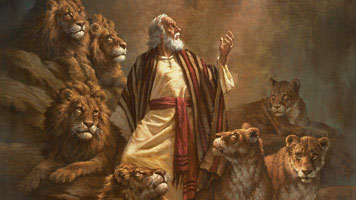 JEHOVAH sent his angel and closed JEHOVAH sent his angel and closed the mouths of the lions. |
It was during the 70-years Babylonian Captivity of the Jews that the Prophet Daniel saw all of his visions and dreams. To this day, not one shred of evidence has been presented to disprove any of his prophecies.
